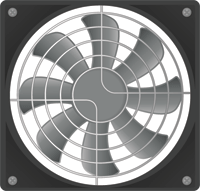Ventilation Systems Should Do More Than Simply Circulate Air
New or old, homes have to maintain a minimal level of air circulation to expel polluted inside air and replace it with fresh outside air. If you plan to upgrade or need repairs on your existing ventilation system, first identify the type of ventilation in use now. Consider the South Florida climate, your budget and learn about the types of ventilation best suited to both.
Exhaust Ventilation
This system works through depressurization. Air is exhausted from your home and new air enters through installed passive vents and leaks in the home’s outer shell. No fans exhaust or pull fresh air inside, which otherwise might allow outside pollutants entry to your home. In hot, humid climates with these systems, the formation of mold becomes worrisome, as the system does not remove moisture from the incoming air.
Supply Ventilation
A central fan draws air into one or more frequently used rooms from the outside while forcing air out through built-in vents and cracks in the house’s shell. The ductwork draws outside air into a centralized vent to control the introduction of outside pollutants. A filter used with the system cleans the incoming air further. Exhaust fans placed in bathrooms and kitchens remove moist air and odors. Supply ventilation systems work well in hot climates where winters remain mild.
Balanced Ventilation
This system employs two fans; one exhausts air from the home while the other draws fresh air into the home. The fan and ducts direct fresh air to rooms occupied most often while the exhaust fan pushes air out of rooms containing moisture and odors (bathrooms and kitchens).The intake and outflow of air remain even, so your home neither depressurizes nor pressurizes. Balance ventilation systems work in all climates.
Energy and Heat Recovery Ventilation
These relatively sophisticated systems use parallel air streams to transfer heat between inflowing air and outflowing air, switching the direction of the transfer depending on the whether it’s the heating or cooling season. Energy recovery ventilators also transfer moisture to inside or outside air streams depending on the season.
Home ventilation systems need to do more than circulate air. While shopping for upgrades or speaking to a repair professional make sure the system:
- Runs smoothly and quietly
- Cleans the air upon intake for everyone’s health
- Comes with easy-to-use controls
- Evenly distributes clean air throughout the home
- Meets federral Energy Star standards
Residents in Martin, Palm Beach and Indian River counties are welcome to contact us at NisAir Air Conditioning and Heating for questions about installation or upgrades to your current whole-home ventilation system.

